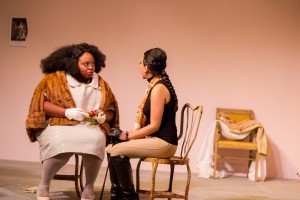In today’s Western civilization, we pride ourselves in the excessive amount of freedom we believe we deserve – but is our extreme freedom one in which morality is applicable, and can freedom have a detrimental effect on the self? In a broad sense, these are the questions that the UR International Theater Program’s new show “Madame de Sade” (written by Yukio Mishima and directed by Nigel Maister) attempts to answer. Whether or not you’re an individual who is open to the concept of sadism (the infliction of pain for pleasure), you’ll appreciate how the show manages to answer these questions.
The show centered around six women, all of whom are related to Donatien “Alphonse” Francois de Sade – a man sentenced to prison for inflicting sexual violence on prostitutes and servants. Alphone’s wife Renee, the titular Madame de Sade (played by sophomore Halle Burns), is especially devoted to her husband and wants him to leave prison – at any cost. This is much to the disdain of her mother, the Madame de Montreuil (played by junior Kathryn Loveless), who cannot understand why her daughter remains devoted to a man who inflicts pain for pleasure. Renee’s sister, Anne (played by freshman Sarah Kingsley), a sly character, is interested in Alphonse too but conceals her extreme devotion to him, unlike her sister. There are three other characters: Baronesse de Simiane (played by senior Makia Green), Comtesse de Saint-Fond (played by junior Evelyn Hernandez), and the housekeeper Charlotte (played by freshman Murie Gillett). Simiane and Saint-Fond initially act as aids to Renee and her mother in helping pull Alphonse out of prison, while Charlotte serves as the innocent observer to the madness of the situation.
The infliction of pain and the oozing of blood for sexual pleasure is a disturbing topic to discuss – it’s often considered taboo. Nevertheless, Maister’s direction of the play and the strong performances by the six women helped make the discussion an easier pill to swallow. Maister opted for a simple set design, which contrasted against two shows produced earlier this season, “A Bright Room Called Day” and “An Enemy of the People.” “Madame de Sade” spans approximately twenty years and occurs in the same room – this can seem claustrophobic for a two and a half hour play. However, the show’s lighting took advantage of such a simple set, creating intense scenes which prevented the show’s length from boring the audience. For example, the blood red lighting during Hernandez’s character’s disturbing monologue involving a black mass and a sadistic beating on the cross will surely provide chills. Also, the costumes are gorgeous – soft, stylish, and sexy.
Admittedly, “Sade”’s plot isn’t quite as captivating as its set design. For a good amount of the show I was profoundly confused as to what was going on. However, after finally catching up with the play at the end of Act I, the show exceeded my expectations, mainly due to its six stellar performances.
Evelyn’s character, Comtesse de Saint-Fond, was easily the most interesting character because of her blunt, sassy attitude and her recounts of grotesque sadistic obsessions – her performance was a pleasure to watch.
Kingsley played the sensual Anne, Renee’s sister. Be warned: though the play is set in the 18th century, Kingsley played Anne as a modern, anachronistic character who doesn’t fit in with the time period. While Anne’s independence exceeds the status quo, her character has a sweet side that Kingsley played well – we all end up liking Anne. Makia’s performance of Baronesse de Simiane, the devout Christian, was intriguing and humorous.
Gillette portrayed the housekeeper Charlotte with simple innocence, and the audience really got to see how she changed from a submissive servant into someone with her own opinion. Charlotte was a rather minor character in the depth of it all, but it was enjoyable nonetheless to see her whenever she did appear; she seemed to be the only sane character in the entire show.
Despite some great performances, there were a couple moments where it was hard to stay attentive to what was going on. Still, every time I thought I was losing interest, something happened which re-engaged me. To be fair though, if you have a short attention span, “Madame de Sade” might be a difficult show to watch. Plus, the third act after the intermission dragged on a bit and wasn’t as exciting to watch compared to the captivating and wonderful Act II that preceded it, although those who embrace the third act’s longevity will be pleased by the play’s climax. Those who do come to this play with an open mind and a willingness to sit through some less exciting scenes will surely be glad they stuck around. The play touched on issues of devotion, misogyny, suffering, and obsession. In fact, the show had moments containing such discrete creepiness and disgust that it made the $7 ticket to see it completely worth it.
“Madame de Sade” is a dark show; if the chains and whips don’t excite you, then the questions about suffering and devotion surely will. Be sure to catch the show, premiering at Todd Theatre on April 24.
Usmani is a member of
the class of 2017.

